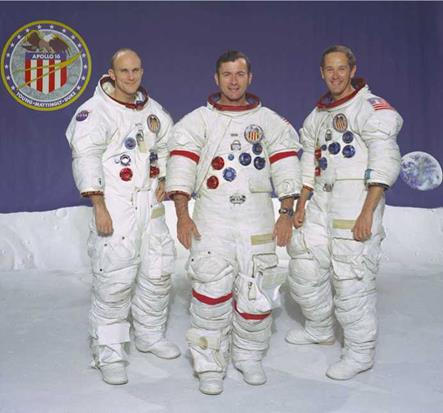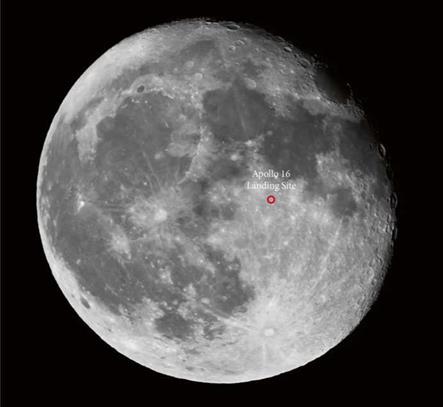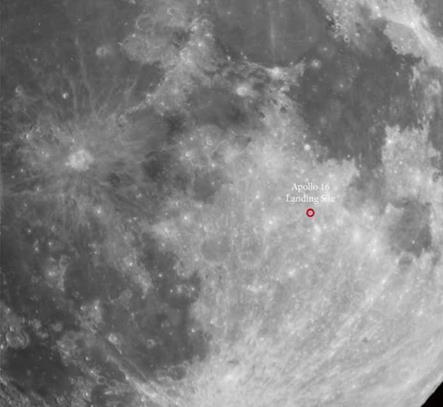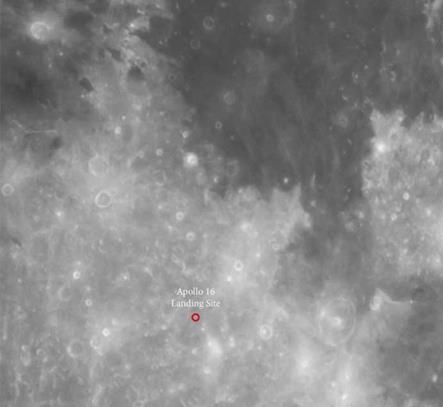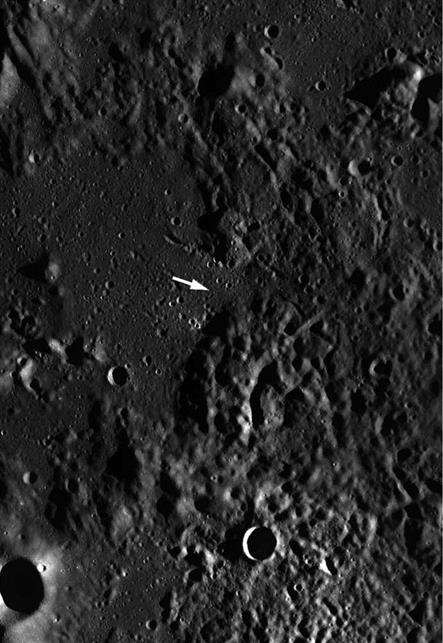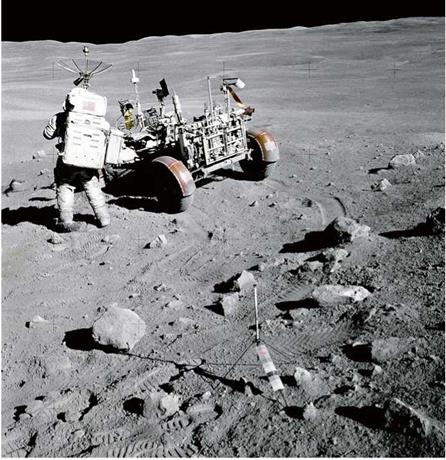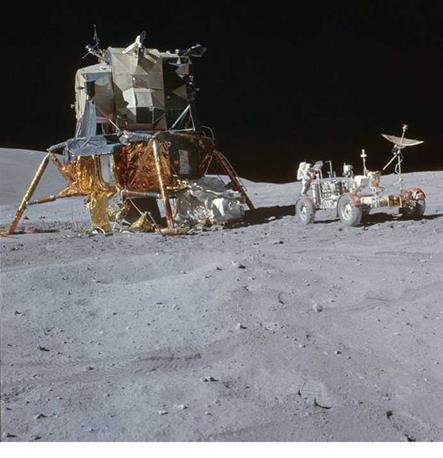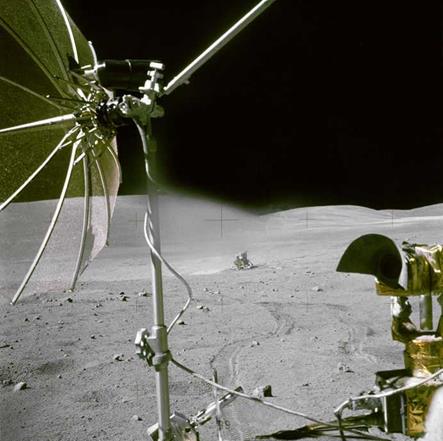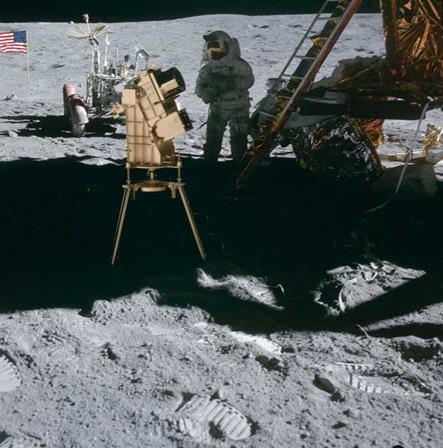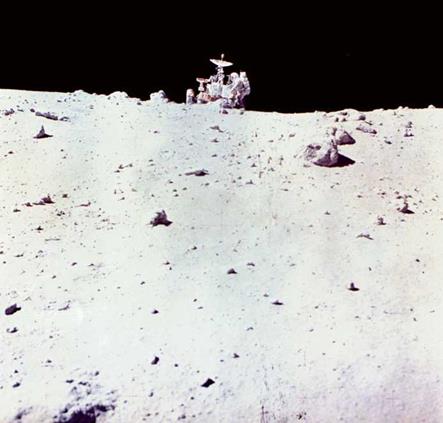Apollo 16
Dates: 16-27 April, 1972
Crew: Commander John Young CM Pilot Tom Mattingly LM Pilot Charlie Duke
Command Module: Casper Lunar Module: Orion
Accomplishments: Landing in the highlands of the Descarte Region.
J. L. Chen, How to Find the Apollo Landing Sites,
The Patrick Moore Practical Astronomy Series, DOI 10.1007/978-3-319-06456-7_8, © Springer International Publishing Switzerland 2014

|
|
|
The primary objectives of the penultimate Apollo mission were as follows:
• to perform geologic surveys and sampling of materials and surface features in
the area of the Hadley-Appennius region
• to deploy and activate surface experiments included in a new ALSEP suite
• to evaluate the capability of the Apollo equipment to operate extended lunar
surface stay time
• to conduct inflight experiments and photographic tasks from lunar orbit, including new photographic surveys and orbital spectrometric data collection
Apollo 16 marked Ken Mattingly’s opportunity to finally fly as CM pilot on a Moon mission. Mattingly (who looks nothing like the Actor Gary Sinise from the movie Apollo 13) had originally been assigned to the prime crew of Apollo 13, but was exposed to the measles through Charlie Duke, a member of the back-up crew for Apollo 13, who contracted the illness from one of his children. Mattingly never contracted the measles, but was nevertheless removed from the crew and replaced by his backup, Jack Swigert, 3 days before the launch. Duke had never flown in space, and both rookie astronauts Mattingly and he were teamed on Apollo 16 with space veteran John Young. Young had previously flown on Gemini 3, Gemini 10, and Apollo 10, and had Space Shuttle STS-1 and STS-9 in his future.
Although not officially announced, the original backup crew consisted of Fred Haise as mission commander, William Pogue as CM pilot, and Gerald Carr as LM pilot, and would have been the prime crew for Apollo 19 under the normal crew rotation scheme. However, after the cancellations of Apollo 18 and 19 in September 1970 due to budget cuts, this crew would not rotate to a lunar mission as planned. With Haise still assigned as backup commander, Stu Roosa and Ed Mitchell were recycled to serve as members of the backup crew after returning from Apollo 14, while Pogue and Carr were re-assigned to the NASA’s first space station Skylab program as part of the Skylab 4 crew.
As a historical note, there was an Apollo 18 mission, but it was not a mission to the Moon. The Apollo portion of the Apollo-Soyuz Test Project (ASTP), the first joint U. S.-Russian space mission, was officially known as Apollo 18. The ASTP was primarily a political space mission which demonstrated detente between the two great nations, by rendezvousing an Apollo space craft with a Soyuz in Earth orbit. This mission marked the final spaceflight for the Apollo command module. Apollo 18 ASTP also was the first and only spaceflight for Deke Slayton, the last of the Mercury 7 astronauts. Slayton was selected to pilot the second U. S. manned orbital spaceflight (eventually flown by Scott Carpenter), but was grounded in 1962 by a heart murmur. He served as NASA’s director of flight crew operations from November 1963 until March 1972, and was responsible for crew assignments at NASA for the Gemini and Apollo programs. Later, he was granted medical clearance to fly, and was assigned as the docking module pilot of Apollo 18, becoming the oldest person at the time to fly in space at age 51.
|
|
|
|
|
|
Up to this point of the Apollo Program, three Apollo Moon landings were in mare regions and the fourth was in ejecta from the Imbrium impact. The objective of the Apollo 16 landing site was to land in the lunar highlands.
There is no easy way to describe in words how to find the Apollo 16 landing site, because of all the Apollo missions, this is the most challenging to spot visually through a telescope. The observer must first spot Sinus Asperitatis, or the Bay of Roughness, just south of the Sea of Tranquility. At the southern end of the Bay of Roughness is a large double crater called Theophilus and Cyrillus. Move westward to spot the Descarte crater, and then slightly north to identify the Apollo 16 site.
The Descartes region west of Mare Nectaris and Alphonsus crater was the main alternative considered for the Apollo 16 mission. Scientists believed prior to Apollo 16, that the Descartes and Cayley Formations were of volcanic origin. The objective for the astronauts was to sample the Descartes Formation and the Cayley Formation. There was observational evidence, gathered from telescope and orbital images, that both formations were volcanic in origin, although formed of magmas that were more viscous than mare lavas. Samples obtained by Apollo 16 have since been analyzed and are actually breccias produced by impacts rather than volcanic activity. From the density of impact craters, the Cayley Formation was thought to be comparable in age to the Imbrium impact. These pre-mission geologic studies suggested that these two formations covered about 11 % of the lunar nearside, making them important for the overall understanding of the Moon’s history. Also, the large distance between the Descartes site and previous landing sites was helpful for the network of geophysical instruments created by the Apollo 12 through 16 missions.
The Alphonsus crater site was considered as an Apollo 16 landing site so as to gather samples from the crater fill itself, possible pre-Imbrium material from the crater wall, and possible young volcanics at some so-called dark halo craters on the floor of Alphonsus. However, some geologists felt that the Alphonsus site had been contaminated by ejecta from the Imbrium Basin impact. The Apollo 16 landing site was selected in June 1971, before the Apollo 14 samples had yet been completely analyzed and the Apollo 15 mission had not yet flown. It was considered possible that the objective of obtaining samples of old highland material (older than the Imbrium impact) might have been met with some of the Apollo 14 or 15 samples.
Therefore, the Descartes landing site was chosen for Apollo 16. The precision of this Moon landing is clearly shown in Fig. 8.6.
|
Fig. 8.6 Zoom in on the Cayley Plains of the Descartes Region. Courtesy of NASA |
Once in lunar orbit, Ken Mattingly was scheduled to perform an engine bum to position Casper for a rescue in the event of an aborted landing. Meanwhile, the LM astronauts Young and Duke powered up the lander and separated from the Command Module. However, during tests of the control systems for the Command Service Module’s steerable rocket engine, an error light lit, indicating a malfunction in the backup system. Mission rules dictated that, at this point, the two spacecraft rendezvous in case it was decided that the crew would have to use the LM engines to get back to Earth, a la Apollo 13. However, after 6 hours of tests and analysis, Mission Control decided that the engine problem could be worked around and that the landing could proceed. The lunar landing was delayed, but not scrubbed.
|
|
|
|
|
|
|
|
|
Fig. 8.12 Charlie Duke with the Far/Ultraviolet Camera/Spectrograph. Courtesy of NASA |
The Apollo 16 crew performed several experiments on the lunar surface. The results of some of these experiments were either radioed to Earth by the crew or returned to Earth for laboratory analysis.
• The Soil Mechanics Investigation studied the properties of the lunar soil.
• The Solar Wind Composition Experiment collected samples of the solar wind for analysis on Earth. In addition to the aluminum foil used in previous Apollo missions, Apollo 16 included a platinum sheet. This foil was exposed to the Sun for 45 hours. The foil was then returned to Earth for laboratory analysis.
• The Lunar Portable Magnetometer measured the strength of the Moon’s magnetic field at different locations in the vicinity of the landing site. This experiment was identical to the device carried on Apollo 14.
• The Far/Ultraviolet Camera/Spectrograph took pictures and spectra of astronomical objects in ultraviolet light, and marked the first time a telescope was used from the Moon. Unique to Apollo 16, it used a 3-in. telescope to obtain images and spectra at wavelengths between 500 and 1,600 A. The telescope consisted of a tripod-mounted, 3-in. Schmidt camera with a cesium iodide cathode and film cartridge. For reference, visible light corresponds to wavelengths of 4,0007,000 A. Emission at these wavelengths comes primarily from very hot stars of spectral classes O, B, and A, with surface temperatures of 10,000° to 50,000°K. For comparison, the temperature at the visible surface of the Sun is about 5,800°K or 11,000 ° F. Stars as faint as magnitude 11, or 100 times fainter than can be seen with the human eye, were recorded. Results were recorded on a film cartridge and returned to Earth for analysis. A total of 178 frames of film were obtained. The telescope was periodically reoriented by the astronauts in order to study various parts of the sky. Among the objects studied were the Earth’s upper atmosphere and aurora, various nebulae and star clusters, and the satellite galaxy of the Milky Way galaxy known as the Large Magellanic Cloud.
• The Cosmic Ray Detector measured very high energy cosmic rays from the Sun and other parts of our galaxy. The detector was physically attached to one of the legs of LM Orion, but the deployment proved to be problematic. The detector was to be deployed by pulling a lanyard on the unit. The deployment lanyard broke. It was only partially deployed due to incorrectly installed screws which interfered with the travel of the plates. This degraded portions of the experiment. By the beginning of EVA-2, the temperature labels indicated that the detector was nearing overheating. The detector was removed from the LM and was placed on one of the foot pads so that it faced away from the Sun. A layer of lunar dust on the equipment contributed to the overheating. The experiment was redesigned for the Apollo 17 mission.
The Apollo 16 crew deployed another ALSEP, with experiments now familiar to
the reader:
• The Passive Seismic Experiment detected lunar tremors and provided information about the internal structure of the Moon. The deployed Apollo 16 PSE gathered seismic data as part of the network that included the ALSEP PSEs’ from Apollo 12, 14, and 15.
• The Active Seismic Experiment provided information about the structure of the upper 100 m of the lunar regolith. On Apollo 16, three of four mortar shells were used to lob explosive charges to distances of up to 900 m from the ALSEP. The fourth mortar shell went unused when a calibration error was detected. The mortars were activated by radio after the astronauts had returned to CM Casper. Hexanitrostilbene was the main explosive fill in the seismic source generating mortar ammunition canisters used as part of the experiment due to its high heat resistance and high insensitivity to impact. The astronauts were also equipped with an astronaut-activated “Thumper” device, which was designed to detonate individually 22 smaller charges, to create a small shocks in the lunar surface. The Apollo 16 crew fired off 19 of the 22 Thumper charges.
• The Heat Flow Experiment attempted to measure the amount of heat coming out of the Moon. Unfortunately, the HFE was damaged when John Young inadvertently caught his foot on the cable that connected the experiment to the Central Station, and pulled the cable out of its connector at the Central Station. Although the damage was repairable, Mission Control ultimately decided that the repair time would adversely impact the completion of other lunar surface tasks. Apollo astronauts on all the missions complained about the presence of the many interconnecting ALSEP cables and the problems of tripping over, stepping on, or snagging a cable was a real issue. So to the surprise of no one, the HFE experiment was terminated.
• The Lunar Surface Magnetometer measured the strength of the Moon’s magnetic field. The magnetometers from Apollo 12, 15, and 16 showed large variations in the magnetic field of the Moon. These variations indicate the presence of strong localized sources in the crust for the Moon’s magnetic field, a conclusion that is also consistent with observations from lunar orbit measurements gained from unmanned lunar probes such as Explorer 35. The Earth’s magnetic field is generated by the flow of fluids in the core and has a global dipole geometry, as seen in a simple handheld compass. The ALSEP results show no evidence of a global encompassing dipole field on the Moon.
|
Fig. 8.13 Looking up the crater. Courtesy of NASA |
The navigation system on the lunar rover failed during the return drive from EVA-2 and, since their outbound lunar rover tracks are out of sight to the east, John Young used horizon features as a guide. The fact that he was aimed directly at the LM is a testament to his landmark recognition skill.
|
Fig. 8.14 A view of the CM Casper from the LM Orion during the rendezvous before heading home to Earth. Courtesy of NASA |
In addition to their studies on the lunar surface, the Apollo 16 crew performed intensive studies of the Moon from lunar orbit. In addition to photography performed with hand-held cameras in the Command Module, a series of experiments were carried in the Scientific Instrument Module on the Service Module. The same suite of SIM bay instruments was also flown on the predecessor mission Apollo 15.
• The Metric and Panometric cameras provided systematic photography of the lunar surface.
• The Laser Altimeter measured the heights of lunar surface features
• The S-Band Transponder Experiment measured regional variations in the Moon’s gravitational acceleration.
• The X-Ray Fluorescence Spectrometer Experiment measured the composition of the lunar surface.
• The Gamma Ray Spectrometer Experiment measured the composition of the lunar surface.
• The Alpha Particle Spectrometer Experiment measured radon emission from the lunar surface.
• The Orbital Mass Spectrometer Experiment measured the composition of the lunar atmosphere. The results of this experiment proved to be as inconclusive as the identical experiment from the Apollo 15 mission.
• The Bistatic Radar Experiment measured the scattering of radar waves from the lunar surface.
• The Subsatellite measured regional variations in the Moon’s gravitational acceleration and magnetic field and the distribution of charged particles around the Moon. The Apollo 16 subsatellite PFS-2 was a small satellite released into lunar orbit from the Service Module. Its principle objective was to measure charged particles and magnetic fields all around the Moon as the Moon orbited Earth, similar to its sister Apollo 15 deployed spacecraft PFS-1. PFS-1 and PFS-2 were deployed in similar elliptical orbits, ranging from 55 to 76 miles above the Moon. However, the orbit of PFS-2 rapidly changed shape and distance from the Moon. Within 2-1/2 weeks of deployment, the subsatellite’s orbit was scrapping over the lunar surface of 6 miles at perigee. The orbit kept changing to the point where PFS-2 perigee was 30 miles. The orbital instability continued, and the subsatellite’s orbit degraded again. On May 29, 1972, PFS-2 crashed into the lunar surface, lasting only 35 days and 425 orbits. In later years, through a study of many lunar orbiting satellites, scientists came to discover that most low lunar orbits (LLO) are unstable. Unlike its predecessor PFS-1, PFS-2 had been unlucky and was placed into one of the most unstable of orbits, with an orbital inclination of 11°, far from the four frozen lunar orbits discovered only later at 27°, 50°, 76°, and 86° inclination.
Upon the return of the crew to the CM Casper, the ascent stage of Orion was sent to the surface of the Moon to provide seismic data. The ascent stage of Lunar Module Orion separated on 24 April 1972, but a loss of attitude control rendered it out of control. It orbited the Moon for about a year. The Orion impact site on the Moon is unknown.
With the precedent established with the Apollo 13, 14, and 15 S-IVB third stages, the Apollo 16 Saturn third stage was intentionally impacted onto the Moon at longitude 1.3° North and latitude 23.8° West. This event provided data to the PSE network created by Apollo 12, 14, 15 and 16 using a known size and mass.
The lunar samples returned by Apollo 16 brought the biggest scientific surprise of the entire Apollo program. During mission planning, scientists believed the Descartes region to be volcanic plains of comparable age to the Imbrium impact basin. The Apollo 16 crew collected 731 individual rock and soil samples, including a deep drill core that included material over 6 feet below the Moon’s surface, for a record total of 208 pounds.
The samples turned out not to be of volcanic nature. Almost every rock collected on Apollo 16 was a breccia. Breccias are rocks that are composed of fragments of older rocks. Rather than being volcanic in nature, the lunar rocks returned by Apollo 16 showed the Descartes region to be composed of breccia created by meteorite impacts. Meteor impacts broke many rocks up into small fragments, and sometimes fused small rock fragments into new breccia rocks. Continual meteorite bombardment of the lunar surface resulted in breccias forming larger breccias.
Apollo 16 geological findings changed the nature of scientific thought over the formation of the lunar crust. The previously held belief of a lunar crust formed by volcanic lava flows was dispelled, and replaced by a more complex concept of some magma flows caused by meteor impacts, followed by layers of meteorite impacts that formed the Moon’s crust. The meteorite impact source of the Descartes breccia is still under debate, whether the breccias were from the Imbrium impact or in combination with earlier meteorite impacts remains to be discovered.
The process of returning and decommissioning CM Casper was not without incident. Following the landing, the aircraft carrier USS Ticonderoga delivered the CM Casper to the North Island Naval Air Station, near San Diego, California, on May 5, 1972. Three days later, ground service equipment being used to empty the residual toxic reaction control system fuel in the Command Module tanks exploded in a Naval Air Station hangar. This is the same type of residual fuel and reaction control system that, when vented during landing, caused the Apollo 15 parachute failure. Forty-six people were sent to the hospital suffering from toxic fumes inhalation. A technician suffered the most serious injury when a ground service equipment cart overturned on him and fractured his kneecap. Physical damage included a hole in the hangar roof 250 feet above the hanger floor, 40 windows in the hangar were shattered, and the CM Casper suffered a 3-in. gash.
LM Casper now resides at the U. S. Space and Rocket Center, Huntsville, AL.
As recently as 2006, the Apollo 16 mission was in the news, as an 11 year old boy discovered a piece of debris following Hurricane Ernesto off the coast of Bath, North Carolina. The yard wide flat sheet of metal had a very faded Apollo 16 mission insignia on it. NASA confirmed the object to be a remnant of the first stage of the Saturn V that launched Apollo 16 towards the Moon. As a reward for returning the historic remnant to NASA, the young man was treated to a tour of the Kennedy Space Center, and was provided with a prime seat to witness the launch of the final mission of the Space Shuttle program STS-135, launched on July 11, 2011.











